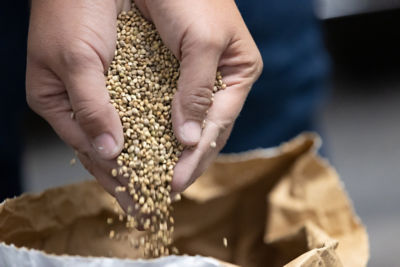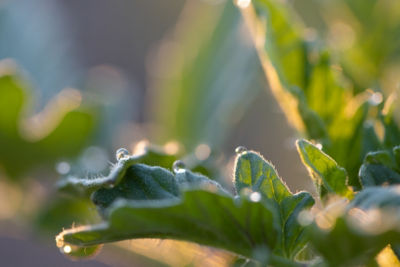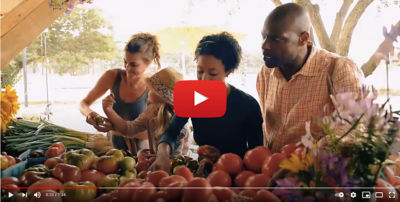Click here to download a PDF version of this spotlight.
» Cucurbit yellow vine disease (CYVD) is a disease of watermelon and other cucurbit crops.
» Understanding the optimal conditions for growing summer squash can help maximize production.
»Direct seeding and transplanting methods are used in squash production systems.
» Optimal conditions and best practices can vary with squash variety and location.
There are many types of summer squash, including straight-neck types, such as zucchini, crook-neck types, and scalloped types, such as patty pan. Summer squash belongs to the species Cucurbita pepo, which also includes jack-o-lantern and pie types of pumpkins and some types of winter squash, such as acorn, delicata, and spaghetti. Summer squashes are warm-season crops that are susceptible to frost damage. Unlike winter squashes, which are usually harvested when physiologically mature, summer squashes are harvested when they are immature with thin skins and immature seeds. The growing season for summer squash is relatively short compared to other vegetable crops, usually 55 to 60 days from planting seed to first harvest. 1,2
PLANTING
In commercial production, summer squash is both direct seeded and transplanted. Squash plants are very sensitive to transplant shock, so direct seeding is the most common method of planting. However, transplanting is becoming more common in regions with short growing seasons and in plasticulture production systems. Direct seeding into plastic mulch-covered raised beds is practiced by some growers.1,2 Direct seeding or transplanting should occur once the danger of early-season frost has passed.
Planting depth affects the emergence rate, with shallowly planted seed emerging before deeper planted seed. Planting depths of 1 to 1.5 inches (2.5 to 4 cm) are recommended for bush-type squash varieties.2,3 The optimum temperature range for germination is usually 70° to 95°F (21° to 35°C), with a maximum of 100°F (38°C). However, varieties can differ in their response to temperature. Germination is usually inhibited at temperatures below 60°F (15°C).1,2
To produce seedlings for transplanting, plant seed in cell trays with 72 to 128 cells per trays (cell diameters of 1 to 1.5 inch).4 Approximately 3.25 pounds of seed are needed to produce 10,000 seedlings.5 Seed should be planted at a depth of one-half inch in soilless planting media with a pH between 5.5 and 6.8. A temperature of 90°F (32°C) is optimal for germination, and seedlings will typically emerge about three days after planting. Seedlings should be transplanted into the field when they are three to four weeks old.1,2,5
Recommendations on plant spacing vary somewhat among regional production guides. For direct seeded bush-type squash crops, recommendations for row spacings range from 30 to 60 inches (90 to 150 cm), and recommendations for in-row, plant-to-plant spacings range from 12 to 24 inches (30 to 60 cm).1,2,3,5,6,7 Higher planting densities can help produce more fruit per area but may also result in reduced fruit size or longer time to harvest.1 When planting transplants on raised beds with plastic mulch, typical row spacings (center to center) are 60 to 72 inches (153 to 183 cm) and within-row spacings of 24 to 36 inches (61 to 91 cm).8
FERTILIZATION
The optimal soil pH range for summer squash growth is 6.0 to 6.8, and pH levels below 5.5 can result in manganese phytotoxicity.7 As with plant spacing recommendations, recommendations for fertilizer applications vary somewhat among regional production guides, partly because of different soil types and soil nutrient availabilities in different regions (Table 1).2,3,5,7,8 Splitting nitrogen (N) applications is recommended, with 30 to 60 lb/A applied pre-plant. The remainder is applied after planting as sidedress applications in non-mulched production or through drip irrigation systems. Phosphorus (P2O5) applications can also be split into pre-plant and sidedress or fertigation treatments after planting. Potassium applications are typically put down pre-plant.2,7,8

IRRIGATION
The root zone of a fully grown squash plant usually occupies the upper 18 inches (45 cm) of the soil, and irrigation applications should move through most of this zone, depending on the age of the plant. Balance irrigation rates and timing to avoid excessive soil moisture and water stress. Application timing and amounts will vary with the water demands (age) of the plants, the soil type (sandy vs. clay), the environmental conditions (light, temperature, humidity, wind), and the amount of rainfall. Sandy soils will require more frequent applications to maintain adequate soil moisture levels between applications.2 Pythium wilt typically develops initially on plants in the rosette stage or older. Symptoms include stunting of plants and yellowing and wilting of the outer, older leaves (Figure 2). The leaves will then turn brown and die. With time the plants will collapse. Sometimes the older affected leaves will collapse, but the younger leaves will remain upright. A dark-yellow to brown discoloration develops on the tap root (Figure 3), and infected plants have reduced root systems and some necrosis of the root tips on small feeder roots. With Pythium wilt, the crown of the plant does not rot, and plants do not break off at the soil line when tugged, as they do with Sclerotinia rot (drop).1,3,6
POLLINATION
Squash plants are monecious with female and male flowers on the same plant (Figure 1). The female flower has an ovary at the base and is borne on a short stem. The ovary will develop into a fruit. The male flower lacks the ovary at the base and is usually borne on a long stem.1,2 The plants are usually self-fertile, with the pollen from the male flower able to fertilize the female flower. However, the pollen is produced in a sticky substance and cannot be carried in air currents. The pollen is usually moved to the female flower by pollinators, usually insects and mostly honey bees. A lack of adequate pollination can result in deformed fruit or fruit abortion, where fruit shrivel and fall off. Cross-pollination between different varieties within Cucurbita pepo will usually result in successful fertilization. This is not a problem in fruit production fields but is a problem for seed production.2 Fruit can reach market maturity three to eight days after pollination, depending on variety and environmental conditions.
Some growers supplement the populations of naturally present bees by placing hives of honey bees in and around the field to help ensure adequate levels of pollination. Typically, one or two hives of bees are recommended per acre. Most pollination occurs in the morning after the flowers open. This is when bees are most active.1,2 Extreme care should be taken when applying pesticides, including fungicides and insecticides, as some products can be harmful to bees and other pollinators. It is best not to apply the most harmful products during the pollination period. All products should be applied in the late afternoon and evening when flowers are closed and few bees are present. Always consult Studies are underway to evaluate methods for managing Pythium wilt. There are some differences in susceptibility among lettuce varieties, but no varieties are completely resistant. Some head types of lettuce appear to be less susceptible to the disease. Trials with Oomycete-specific fungicides have shown some efficacy for slowing the growth of the pathogen in laboratory experiments, and the effectiveness of fungicide seed treatments and soil drenches are being evaluated.3,9

HARVESTING
Harvesting usually begins 40 to 50 days after seeding and 3 to 8 days after pollination.2,3,5 Fruit should be harvested as soon as it reaches the desired size, which depends on market preferences. The seed should be immature, and the skin (rind) should be tender. Take care to avoid damaging the skin during harvest, as this will reduce the marketability.2,7 If fruit are left on the vine and become too large, they act as nutrient sinks, taking nutrients away from other developing fruit and suppressing additional fruit set. Plantings are most productive if harvested every other day. Squash fruit are almost always harvested by hand. Sorting, grading, and packing are often done in the field.2,7
The desired fruit size varies with the target market. For markets in the western U.S., the desired size for zucchini and other straight-neck squash is 5 to 6 inches (12 to 15 cm) and 1.25 to 2 inches (32 to 50 mm) in diameter. For eastern markets, 7 to 8 inches (18 to 21 cm) fruit lengths are often preferred. For crook-neck squash, the desired fruit diameter is also 1.25 to 2 inches (32 to 50 mm), while for scalloped squash, 3 to 4 inches (7 to 10 cm) diameters are usually desired by the market.8
POST-HARVEST HANDLING
As with harvest, fruit should be carefully handled during the post-harvest period to minimize wounding and bruising. Injuries can provide infection sites for pathogens resulting in post-harvest fruit rots and reduced shelf life.1 Fruit should be cooled to 50°F (10°C) promptly after harvest. Delays in cooling can lead to reductions in shelf-life and fruit quality. However, fruit are susceptible to chilling injury at temperatures below 41°F (5°C), so temperatures should be carefully monitored.2,8
Squash fruit should be stored at temperatures between 41°and 50°F (5° to 10°C) and 95% relative humidity. Storage below 41°F can result in pitting of the fruit surface, discoloration, and more rapid decay. Some squash varieties are genetically more susceptible to chilling injury and shriveling of fruit in storage.1,2 Squash usually have a seven to fourteen-day shelf-life when stored at 41°F. Low oxygen levels and exposure to ethylene can reduce the shelf-life of fruit in storage. Therefore, do not store or transport squash with crops that produce ethylene.2,8
SOURCES
1 Wehner, T., Naegele, R., Myers, J., Dhillon, N., and Crosby, K. 2020. Cucurbits, 2nd Edition, Crop Production Science in Horticulture. CABI, Oxfordshire, UK.
2 Molinar, R., Aguiar, J., Gaskell, M., and Mayberry, K. Summer Squash Production in California. University of California DANR Publication 7245.
3 Freeman, J., McAvoy, E., Frey, C., Boyd, N., Paret, M., Wang, Q., Desaeger, J., Qureshi, J., Meszaros, A., and Martini, X. 2022. Cucurbit Production. In Vegetable Production Handbook of Florida, 2022-2023 edition, Dittmar, P., Agehara, S., and Dufault, N., editors. UF-IFAS Extension.
4 Drost, D. Transplant production: cucumber, pumpkin, squash. Utah Vegetable Production & Pest Management guide. Utah State University. https://extension.usu.edu/vegetableguide/ cucumber-melon-pumpkin-squash/transplant-production.
5 Maynard, D. and Hochmuth, G. 1997. Knott’s handbook for vegetable growers, fourth edition. John Wiley & Sons. New York.
6 Reiners, S., Bihn, E., Curtis, P., Helms, M., McGrath, M., Nault, B., Seaman, A., and Sosnoskie, L. 2022 Cornell Integrated Crop and Pest Management Guidelines for Commercial Vegetable Production. Cornell Cooperative Extension.
7 Phillips, B., Nair, A., Bergefurd, B., Egel, D., Ingwell, L., and Meyers, S. 2023. Midwest vegetable production guide for commercial growers 2023. https://mwveguide.org/.
8 Wyenandt, C., man Vuuren, M., Owens, D., Johnson, G., Hamilton, G., VanGessel. 2022/2023 Mid-Atlantic commercial vegetable production recommendations.
Websites verified 3/21/2023
ADDITIONAL INFORMATION
Performance may vary from location to location and from year to year, as local growing, soil and weather conditions may vary. Growers should evaluate data from multiple locations and years whenever possible and should consider the impacts of these conditions on the grower’s fields. The recommendations in this article are based upon information obtained from the cited sources and should be used as a quick reference for information about vegetable production. The content of this article should not be substituted for the professional opinion of a producer, grower, agronomist, pathologist and similar professional dealing with vegetable crops.
BAYER GROUP DOES NOT WARRANT THE ACCURACY OF ANY INFORMATION OR TECHNICAL ADVICE PROVIDED HEREIN AND DISCLAIMS ALL LIABILITY FOR ANY CLAIM INVOLVING SUCH INFORMATION OR ADVICE.
6614_207402 Published 03/24/2023




